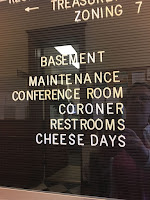
Larry, Amy, and I just spent five days in Wisconsin. The idea behind the trip was to solidify Amy’s decision to be a Badger next year. That sort of backfired, though, since Amy did not enjoy the University of Wisconsin Admitted Students Day in Madison, whereas Larry and I had an excellent time wandering around campus and drinking beer.
Luckily the weather was great. We spent Friday afternoon exploring coffee
shops on State Street, where Amy had an excellent cup of chai. On Saturday
morning we attended the weekly Farmer’s Market around the beautiful Capitol
Building, ate some excellent cheese bread, and saw a lot of adorable dogs and
babies. So now UW passes muster.
We then headed out to rural
Wisconsin to stay on a farm. We had
never done a farm stay before, but I am now a convert.
Amy chose the Circle M Farm because
the reviews all mentioned the excellent breakfasts, and she knows how much I
love breakfast. She’s such a good girl. The breakfasts were indeed amazing. We had bacon from pigs raised on the farm, chicken
and goose eggs collected in the morning, fresh herbs, honey from the next farm
over, etc. etc.
The farmers (husband and
wife, I made the mistake of referring to the wife as a “farm wife” within her
hearing exactly one time) are lovely people and they work SO HARD. I thought I had a pretty easy life before I
stayed on a farm, and that has been confirmed.
While they worked, we spent
our days cruising around the Driftless Area in our car visiting very small
historic towns and drinking more beer.
We saw lots of farms and cows.
And ate lots of cheese.
I borrowed a book from the
farm entitled “This Is Wisconsin” by Robert Gard, published in 1969. It is a collection of oral histories
collected by a UW professor as he travelled around the state. The lives of pioneer Wisconsin farming, fishing,
logging, and mining folk were difficult and pretty crazy.
The can-do attitude, self-reliance,
and hospitality of early Wisconsinites is still evident in Wisconsin
today. It is a fascinating place, and
Amy has to go to school there, because I want to visit more places and eat more
cheese.


